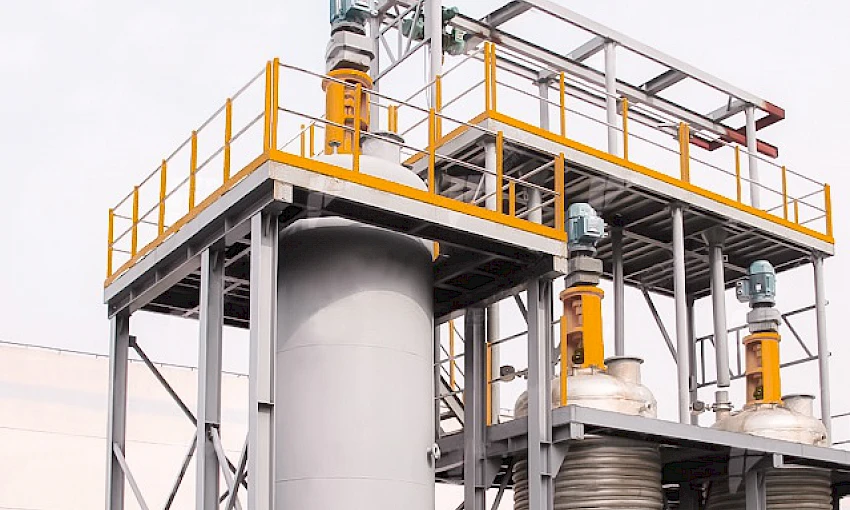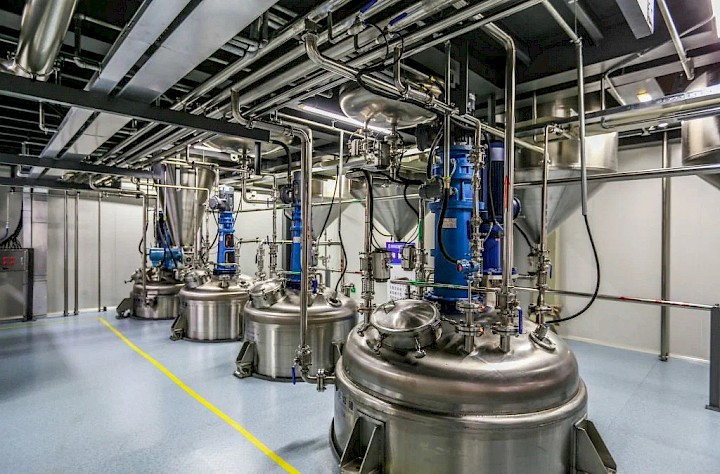
Adhesive Manufacturing Plants: Factory Setup and Commissioning
Adhesive manufacturing plants are specialized facilities equipped with cutting-edge technology for the production and packaging of adhesive materials. These plants are optimized to meet industrial and commercial needs. Adhesive manufacturing plants oversee the production processes of these adhesives, ensuring proper formulation, homogeneous mixing of raw materials, achieving the correct viscosity values, and guaranteeing the quality of the final product.
Technical Specifications of Adhesive Plants
Adhesive plants are designed for the production of adhesives used to bond various materials. The technical specifications of adhesive plants can vary depending on the size, capacity, and production requirements of the facility. However, in general, the technical specifications of adhesive plants may include the following elements:
-
Production Capacity: The production capacity of adhesive plants indicates how much adhesive the plant can produce per day or hour. Production capacity varies depending on the size of the facility, the equipment used, and the production process.
-
Production Process: In adhesive plants, the production process involves the following stages:
-
Raw material preparation: The main components of the adhesive are combined into a homogeneous mixture in a mixing tank.
-
Reactions: If necessary, chemical reactions take place between the raw materials.
-
Cooling or drying: The adhesive is cooled or dried until it reaches the desired viscosity and structure.
-
Packaging and storage: The adhesive is packaged and stored.
-
-
Raw Materials and Chemicals: The raw materials used in adhesive production determine the properties of the adhesive. The main components of the adhesive are resins. However, solvents, pigments, additives, and other chemicals can also be used to improve the properties of the adhesive.
-
Equipment: The equipment used in adhesive plants increases the efficiency and consistency of the production process. The main equipment used in adhesive plants are:
- Mixing tanks: Used to combine the main components of the adhesive into a homogeneous mixture.
- Reactors: Used for chemical reactions between raw materials when necessary.
- Dryers: Used to dry the adhesive until it reaches the desired viscosity and structure.
- Storage tanks: Used to store the adhesive.
- Packaging machines: Used to package the adhesive.
-
Quality Control: In adhesive plants, the quality of the produced adhesive is regularly checked. This is done to ensure that the adhesive has the desired properties. The main quality control tests used in adhesive plants are:
- Adhesion test: Measures the adhesive strength of the adhesive.
- Viscosity test: Measures the fluidity of the adhesive.
- Drying test: Measures the drying time of the adhesive.
- Durability test: Measures the durability of the adhesive.
-
Occupational Safety and Environmental Regulations: In adhesive plants, necessary precautions are taken to protect the safety of employees and the environment. These precautions relate to the design, equipment, and operating procedures of the facility.
-
Packaging and Storage: The adhesive is packaged and stored. Packaging is done to prevent the adhesive from spoiling and to facilitate its transportation. Storage is done to ensure that the adhesive is preserved in the desired quality.
-
Energy and Water Use: Energy and water use in adhesive plants are important in terms of efficiency. The equipment used in adhesive plants can be designed to reduce energy and water consumption.
-
Automation and Control Systems: Automation and control systems are used in adhesive plants to monitor production processes, record data, and optimize operations.
-
Operating Costs: The operating costs of adhesive plants include personnel expenses, energy costs, the cost of raw materials, and other expenses.
These features reflect the general technical requirements of adhesive production facilities. However, the characteristics of each facility may vary depending on market demands and production targets. In addition, it is important that the facilities comply with local regulations and standards.
Areas of Use for Adhesives
Adhesive is a product used to bring different materials together, fix them, or bond them. The areas of use for adhesives are quite wide and are commonly used in many different sectors.

Some Sectors Where Adhesive is Used:
-
Construction industry: In the construction industry, adhesive is used to join concrete, stone, wood, ceramic, and other building materials, to fix and bond insulation materials.
-
Automotive industry: In automobile production, adhesive is used to bring together different components of vehicles. This is especially important for purposes of weight reduction, strength, and sound insulation.
-
Packaging industry: In the packaging industry, adhesive is used to bond and seal boxes, bags, and other packaging materials.
-
Wood processing and furniture production: In the wood processing industry, adhesive is widely used in the production of furniture, wood panels, and other wood products.
-
Paper and cardboard production: In the production of paper and cardboard, adhesive is used in roll gluing, double-sided bonding, and packaging processes.
-
Electronics and electrical sector: Adhesive is used in the assembly of electronic components and fixture bonding.
-
Leather and textile sector: Adhesives are used in the bonding of leather products and the production of textile products.
-
Medical and health sector: Adhesives are used in the assembly of medical devices and the production of products used in the healthcare sector.
-
Food and industrial sectors: Adhesives are used for bonding food packaging, pharmaceutical packaging, and the packaging of industrial products.
Advantages of Adhesives
Adhesives have many advantages. The main advantages of adhesives are:
-
Cost: Adhesive is a more economical option compared to other joining methods.
-
Speed: Adhesive can be applied more quickly and easily compared to other joining methods.
-
Usability: Adhesive can be used to join different materials.
-
Durability: Adhesive provides high strength and durability.
What are Adhesive Plants?
Adhesive production plants are specialized facilities focused on the production and packaging of adhesive materials with state-of-the-art equipment. These facilities are optimized to meet industrial and commercial requirements. Adhesive production plants meticulously supervise the production processes of these adhesives. These processes include the precise determination of the formulation, the homogeneous mixing of raw materials, and ensuring that the final product reaches the specified viscosity values. These facilities also implement strict quality control procedures to ensure the quality of the final product and the ultimate bonding performance of the adhesive.
Cost of Setting Up an Adhesive Plant
The cost of setting up adhesive plants varies depending on the size of the facility, its capacity, machinery and equipment,and the technology to be used. Here are some of the main factors affecting the cost of setting up adhesive plants:
- Plant Size and Capacity: The size of the facility and its daily/weekly production capacity are among the main factors determining setup costs. Larger and higher capacity facilities generally require more investment.
- Technology and Equipment: The production technology and equipment to be used are an important cost factor. The level of automation, capacity, and production methods affect the cost of the facility.
What are the Types of Adhesives?
Adhesives can be divided into different types according to their areas of use and properties.
The types of adhesives according to their areas of use are:
-
General purpose adhesives: Adhesives used to bond a wide variety of materials.
-
Special purpose adhesives: Adhesives designed for a specific application. For example, special purpose adhesives are used to bond materials such as wood, metal, plastic, leather, and textile.
The types of adhesives according to their properties are:
-
Thermoplastic adhesives: Adhesives that provide adhesion by melting with heat.
-
Thermoset adhesives: Adhesives that provide adhesion by hardening with heat.
-
Solvent-based adhesives: Adhesives that use the evaporation of solvents for adhesion.
-
Water-based adhesives: Adhesives that use the evaporation of water for adhesion.
-
Polymer-based adhesives: Adhesives that provide adhesion through the reaction of polymers.

What are Adhesive Raw Materials?
The main components of adhesives are resins. Resins are substances that provide the adhesive properties of the adhesive.The resins used in the production of adhesives are:
-
Polyvinyl acetate (PVAc): A water-based, commonly used resin. It is used to bond materials such as wood, paper,cardboard, and textiles.
-
Epoxy resins: Resins with high adhesive strength and durability. They are used to bond materials such as metal,plastic, and ceramic.
-
Polyurethane resins: Resins known for their flexibility and durability. They are used to bond materials such as leather, textiles, and rubber.
-
Acrylic resins: Water-based, easy-to-apply resins. They are used to bond materials such as wood, metal, plastic, and glass.
-
Rubber resins: Resins known for their flexibility and durability. They are used to bond materials such as rubber,leather, and textiles.
Other raw materials used in the production of adhesives are:
-
Solvents: Used to reduce the viscosity of the adhesive and facilitate its application.
-
Pigments: Used to provide the coloring of the adhesive.
-
Additives: Used to improve the properties of the adhesive.
The ratio and type of raw materials used in the production of adhesives determine the properties of the adhesive.
What are Adhesive Production Machines?
The machines used in adhesive production may vary depending on the type and properties of the adhesive. However, in general, adhesive production machines perform the following basic functions:
-
Preparation of raw materials: The main components of the adhesive are combined into a homogeneous mixture in a mixing tank.
-
Reactions: If necessary, chemical reactions take place between the raw materials.
-
Cooling or drying: The adhesive is cooled or dried until it reaches the desired viscosity and structure.
-
Packaging and storage: The adhesive is packaged and stored.
Adhesive production machines are:
-
Stainless Steel Tanks: Ensures the safe storage of raw materials.
-
Mixers: Used to combine the main components of the adhesive into
Adhesive Manufacturing Plants: Factory Setup and Commissioning
Adhesive manufacturing plants are specialized facilities equipped with cutting-edge technology for the production and packaging of adhesive materials. These plants are optimized to meet industrial and commercial needs. Adhesive manufacturing plants oversee the production processes of these adhesives, ensuring proper formulation, homogeneous mixing of raw materials, achieving the correct viscosity values, and guaranteeing the quality of the final product.
Call to Action:
Ready to optimize your adhesive production?
Our expert team will guide you through every step of the process, from design and installation to commissioning and ongoing support.














































